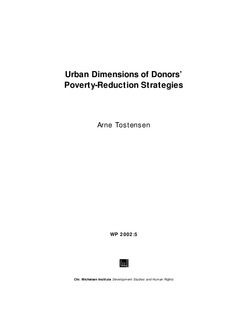| dc.contributor.author | Tostensen, Arne | |
| dc.date.accessioned | 2008-02-25T10:13:43Z | |
| dc.date.accessioned | 2017-03-29T09:12:02Z | |
| dc.date.available | 2008-02-25T10:13:43Z | |
| dc.date.available | 2017-03-29T09:12:02Z | |
| dc.date.issued | 2002 | |
| dc.identifier.isbn | 82-8062-027-3 | |
| dc.identifier.issn | 0804-3639 | |
| dc.identifier.uri | http://hdl.handle.net/11250/2435730 | |
| dc.description.abstract | This paper examines the extent to which the poverty-reduction strategies of selected multilateral and bilateral donors incorporate an urban poverty dimension. Key policy documents of multilaterals such as the World Bank, the UNDP, Habitat and IFAD are scrutinised, as well as those of two bilateral agencies: DFID and Sida. It appears that urban poverty has moved up on the policy agenda of many agencies but notions of ‘urban bias’ still linger in the analyses of some. It is particularly noteworthy that the persistent and widespread urban-rural linkages are given inadequate attention in virtually all policy documents, with potentially serious consequences for aid interventions. | |
| dc.language.iso | eng | |
| dc.publisher | Chr. Michelsen Institute | |
| dc.relation.ispartofseries | CMI Working paper | |
| dc.relation.ispartofseries | WP 2002: 5 | |
| dc.subject | Urbanisation | |
| dc.subject | Urban poverty | |
| dc.subject | Poverty reduction | |
| dc.subject | Donors | |
| dc.title | Urban Dimensions of Donors' Poverty-Reduction Strategies | |
| dc.type | Working paper | |
